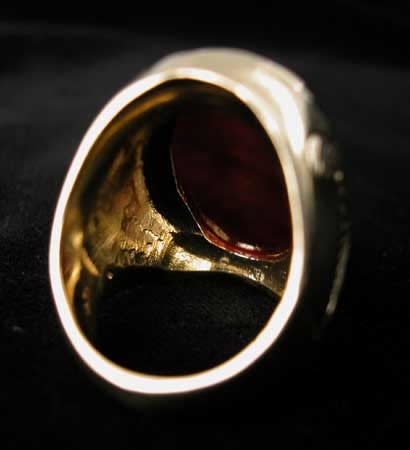Gold Ring with Classical Revival Carnelian Intaglio of a Deity, 18th Century CE
Carnelian and Gold
FJ.7138a
Further images
The art of glyptics, or carving on colored precious stones, is probably one of the oldest known to humanity. Intaglios, gems with an incised design, were made as early as...
The art of glyptics, or carving on colored precious stones, is probably one of the oldest known to humanity. Intaglios, gems with an incised design, were made as early as the fourth and third millennia B.C. in Mesopotamia and the Aegean Islands. The exhibit a virtuosity of execution that suggests an old and stable tradition rooted in the earliest centuries. The tools required for carving gems were simple: a wheel with a belt-drive and a set of drills. Abrasives were necessary since the minerals used were too hard for a metal edge. A special difficulty of engraving intaglios, aside from their miniature size, was that the master had to work with a mirror-image in mind.
The Classical Revival was a phenomenon that swept through Europe in the 18th and 19th Centuries. A new appreciation for antiquity and ancient art forms was fostered by discoveries in the nascent scientific field of archaeology. Perhaps the Classical Revival also reveals a latent longing towards the Arcadian lifestyles of yesterday abandoned as Europe became rapidly industrialized and increasingly urbanized. On this stunning intaglio, a standing deity has been depicted, holding a staff in one hand and Victoria, the Roman Goddess of Victory, in the other. Victoria, resting in his pal, looks up at the god and prepares to crown him with a laurel wreath, the mark of a champion. Who might this god be? Mars? Mercury? Regardless of the specific identifications of the god, it is clear that the artist has captured his divine image in the carnelian gemstone.
The Classical Revival was a phenomenon that swept through Europe in the 18th and 19th Centuries. A new appreciation for antiquity and ancient art forms was fostered by discoveries in the nascent scientific field of archaeology. Perhaps the Classical Revival also reveals a latent longing towards the Arcadian lifestyles of yesterday abandoned as Europe became rapidly industrialized and increasingly urbanized. On this stunning intaglio, a standing deity has been depicted, holding a staff in one hand and Victoria, the Roman Goddess of Victory, in the other. Victoria, resting in his pal, looks up at the god and prepares to crown him with a laurel wreath, the mark of a champion. Who might this god be? Mars? Mercury? Regardless of the specific identifications of the god, it is clear that the artist has captured his divine image in the carnelian gemstone.





